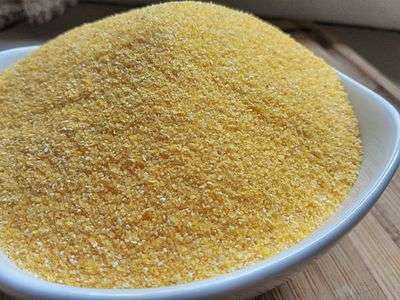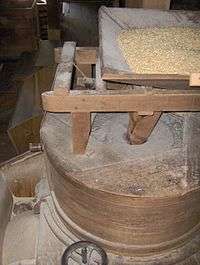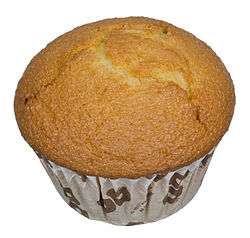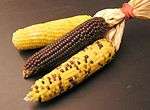Cornmeal
Cornmeal is a meal (coarse flour) ground from dried maize (corn). It is a common staple food, and is ground to fine, medium, and coarse consistencies, but not as fine as wheat flour.[1] In Mexico, very finely ground cornmeal is referred to as corn flour.[1] When fine cornmeal is made from maize that has been soaked in an alkaline solution, e.g., limewater (a process known as nixtamalization), it is called masa flour, which is used for making arepas, tamales and tortillas. Boiled cornmeal is called polenta in Italy and is also a traditional dish and bread substitute in Romania.

Types
There are various types of cornmeal:
- Blue cornmeal is light blue or violet in color. It is ground from whole blue corn and has a sweet flavor. The cornmeal consists of dried corn kernels that have been ground into a fine or medium texture.[2]
- Steel-ground yellow cornmeal, which is common mostly in the United States, has the husk and germ of the maize kernel almost completely removed. It is conserved for about a year if stored in an airtight container in a cool, dry place.[3]
- Stone-ground cornmeal retains some of the hull and germ, lending a little more flavor and nutrition to recipes. It is more perishable, but will store longer if refrigerated. However, it too can have a shelf life of many months if kept in a reasonably cool place.[2]
- White cornmeal (mielie-meal), made from white corn, is more common in parts of Africa. It is also popular in the Southern United States for making cornbread.[2]
Regional usage
Caribbean
- Cornmeal porridge - a popular meal served for breakfast in Jamaica.
- Cou-cou - part of the national dish of Barbados, "cou-cou and flying fish".
- Funche - a typical breakfast in Puerto Rico cornmeal cooked with coconut milk, milk, raisins, butter, cloves, vanilla, ginger, sugar or honey and topped with fruit and cinnamon. There's also a savory funche made with cornmeal, coconut milk, chicken stock, sofrito and other ingredients. These is usually served with fish.
- Funchi also known as fungi/fungee - a cornmeal mush cooked and cooled into a stiff pudding, sometimes eaten with saltfish and/or pepperpot. It is consumed on the island of Curaçao and is part of the national dish of Antigua and Barbuda.
- Mayi moulen - a cornmeal dish in Haiti often cooked with fish and/or spinach. Can be eaten with avocado.
East Asia
- Tie Bing (貼餅 sticking bread) - This product can either be fluffy like a mantou or more flatbread-like. It is traditionally stuck around the outer rim of a large wok while meat or fish is being cooked. Generally, an alkalizing agent such as baking soda is added to increase the nutrient value. It is also found in northern China.
- Corn congee (棒子麵粥) - A porridge made from plain cornmeal. It is normally thinner than grits or polenta and is often eaten with Chinese pickles.
- Wo tou (窩頭 nest head) - Shaped like a hollow cone, this cornbread looks like a bird's nest, after which it is named. It is commonly eaten in northern China, and may contain dried jujubes and other flavoring agents.
Rest of Sub-Saharan Africa
- Tuwo masara - Northern Nigeria
- Mielie-meal - Southern Africa
- Nomadi - Democratic Republic of the Congo
- Nshima or bwali - Zambia
- Nsima - Malawi
- Oshifima or Oshimbob - Namibia
- Sadza - Zimbabwe
- Ugali - Great Lakes (sima and posho in Uganda)[4]
- Recipes that may use cornmeal as an additional ingredient are fufu (foufou) in Central and West Africa.
Europe
- Arapash or harapash - Albania (similar to the Romanian style but often combined with lamb organs, or/and goat cheese)
- Farina di granturco - Italy (not the same as farina, which is made from wheat)
- G'omi ( Georgian: ღომი), mchadi (Georgian: მჭადი), tchvishtari - Georgia (g'omi is similar to polenta, mchadi - cornbread, tshvishtari - cheese cornbread). Known by different names in local languages (Abkhazian: абысҭа abysta, Adyghe: мамрыс mamrys, Ingush: журан-худар juran-hudar, Nogai: мамырза mamyrza, Ossetian: дзыкка dzykka or сера sera), it is also widespread in other Caucasian cuisines.
- Kachamak (качамак) - Bulgaria, North Macedonia and Serbia
- Mălai - Romania (the cornmeal itself; prepared as mămăligă)
- Polenta - southern Europe, especially Italy
Horn of Africa
East Africa
- Ugali - Kenya, Uganda, Tanzania
- Cornmeal is a staple food in the East Africa region. It is used to make Ugali and Uji.
Indian Ocean
- Poudine maïs - Mauritius
This is a local dessert dish made from maize flour in which milk, sugar, dried sultanas and cardamon powder are cooked together. The cooked paste is poured on a tray and coconut powder is sprinkled thereon and left to cool. This dessert is often cut into triangular shapes and can be bought from food vendors in the streets of Port Louis and also in market fairs around the island.
South America

North America

- Masa or Masa harina - Nixtamalized corn used for making tamales and tortillas in Central America, Mexico, and South America.[5]
- As a batter for a fried food, such as corn dogs
- Made into bread, as in corn fritters, cornbread, hushpuppies, jonnycakes, or spoonbread
- As breading for fried or baked foods, such as fried fish
- As a breakfast cereal ingredient
- Cheese curl-type snack foods, such as Cheetos and Cheezies
- In corn chips such as Fritos, but not tortilla chips or corn tortillas, which are made from nixtamalized maize flour
- As a release agent to prevent breads and pizza from sticking to their pans when baking
- As grits
- As a porridge, such as cornmeal mush, which is often then sliced and grilled[7]
- Known as "samp", it was used in colonial times as a kind of porridge.[8]
South Asia
- Makki di roti - a traditional Punjabi bread often eaten with saag in Punjab province of northern India and eastern Pakistan
In parts of northern India and Pakistan ground corn flour is used to make thick slabs of bread which can be eaten with a wide variety of curry dishes or it can be coated in clarified butter or ghee and eaten with yogurt or lassie which is a yogurt based drink especially in summer.
See also
References
- Herbst, Sharon, Food Lover's Companion, Third Edition, Pg. 165, Barrons Educational Series Inc, 2001
- Kilbride, Philip; Goodale, Jane; Ameisen, Elizabeth, eds. (1990). Encounters With American Ethnic Cultures. Tuscaloosa, Alabama: University of Alabama. p. 82. ISBN 0-8173-0471-1. Retrieved July 24, 2010.
- "Section II: Food Commodity Fact Sheets". Commodities Reference Guide. USAID. Archived from the original on 2013-02-17. Retrieved 2013-10-26.
- chefbrad (2008-05-02). "Ugali Recipe (African cornmeal mush)". Whats4eats. Retrieved 2020-05-28.
- Blazes, Marian. "Masarepa - - Precooked Corn Flour for Making Arepas". About Food. Retrieved July 8, 2015.
- "La storia della polenta" [The history of polenta]. I primi d'Italia (in Italian). Archived from the original on 2 December 2013. Retrieved 31 January 2016.
- "Fried Cornmeal Mush Recipe". Allrecipes. Retrieved 2018-11-26.
- Network, The FOURnet Information. "Samp - Recipe - Cooks.com". www.cooks.com. Retrieved 2018-11-26.
External links
| Wikimedia Commons has media related to Corn flour. |
